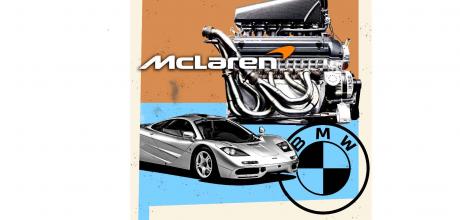McLaren and BMW reunited?
A deal could be struck that gives Munich carbon know-how and Woking some much-needed e-tech – but the obstacles to be overcome are considerable.
Call it a high-performance fling or a one-car stand. Whatever the status, the brief affair that generated the legendary three-seat McLaren F1 powered by that awesome 6.1-litre BMW V12 wrote a small yet memorable chapter of automotive history in the early 1990s. Earlier this year, the British sports car maker and the German premium manufacturer once again met behind closed doors to discuss a project which focuses on two new electric cars, each of which could appear in BMW and McLaren guises: a supercar and a high-performance carbonfibre crossover.
THE SUPERCAR
After the F1, there was talk of a less extreme joint sports car project which came to nothing despite resurfacing twice, most recently in 2019. Now, the ambition is a new halo car with an exceptionally light and stiff carbonfibre matrix engineered and assembled in the UK, with Munich supplying the high-performance batteries, e-motors, inverters and software. BMW needs an answer to the electric Audi R, about five years down the road, and the two electric sports cars Mercedes-AMG has coming in 2027-2028, not to mention the prospect of an electric Porsche 911.
McLaren’s own product plan indicates that its first zero-emissions car will debut in late 2026. The provisionalplan is for an all-wheel-drive Super Series coupe with 1088bhp from four e-motors. Is there room for an extra model – something that could become an electric heir to the BMW M1? And if so, how must it differ from the McLaren?
Neither party likes the idea of making one car with two badges. Instead, there would be distinct designs, inside and out. Beneath the skin, there would be much greater commonality. There are calls from both sides to start from scratch with an all-new platform which has a target base weight of 1500kg. ‘McLaren impressed us by rethinking the way a modern sports car should be engineered and built – their fresh approach to the integration of key components is particularly clever,’ applauds a source from Bavaria.
THE CROSSOVER
The benefits of a partnership are less clear as far as the still sketchy crossover is concerned. The previous McLaren leadership flatly rejected an SUV, claiming it would go against the grain of the puristic brand image. But this categoric veto is increasingly difficult to uphold now that even the most loyal sports car customers are fast developing a taste for taller but still very powerful vehicles; even Ferrari has succumbed to the demands of the market.
It would clearly be a complete departure for McLaren, but for BMW the question is what would it replace? The range is already laden with SUVs. The answer may be to replace the 8-series Gran Coupe with something more akin to a roomy four-seater with SUV overtones, but a seat height as low as an estate car’s; think Taycan, not Cayenne.
THE OBSTACLES
Progress has been slow in recent months, especially when word spread around that Audi was about to take McLaren over. ‘The risk that our know-how would filter through to the competition had become too high,’ recalls a former member of the task force. It took time to clear the air, just as it took time to appoint Michael Leiters as McLaren CEO. BMW CEO Oliver Zipse is claimed to have thrown the biggest spanner in the works when McLaren and the M division last came close to a deal. What’s different this time around? ‘Because the final effort has to be a two-way street, an arrangement of mutual benefit, a clear win-win situation,’ states a person deeply involved in the project.
What exactly is it that the M division cannot create all by itself? Bear in mind that in 2021, M sold 163,542 cars; McLaren sold 2138. Where are the weak links of the Bavarian go-faster division? A BMW engineer has some answers: ‘McLaren is quicker, leaner, more flexible, willing and able to take bigger risks. They do small-volume production runs at costs we can only dream of. But their main asset is of course the carbonfibre know-how.’
M boss Frank van Meel has said: ‘In the future, every new M model must be lighter, more efficient and quantifiably sportier in the way it drives and performs.’ McLaren can help their German friends to get the weight down, create a second-ton-one torsional rigidity and add a unique selling feature not even Ferrari can match across the range. BMW for its part can supply advanced software and the bespoke electric componentry which help to pave the way for faster charging cycles and an acceptable range for sporty drivers.
The 2026 to 2028 timeframe seems to play into the hands of both parties because the next battery revolution and the advantages it entails are about four years away. Which is another way of saying that the grace period for a deal will likely run out before the end of this year.
McLaren and BMW: who wins?
BMW’s push upmarket and expansion of its M division into new segments can be boosted by McLaren’s carbonfibre engineering nous and lightweighting ethos.
McLaren’s in the throes of electrifying its range, with the Artura the first salvo. Access to BMW’s highly efficient batteries and e-motors could help McLaren hit its product plan goals quicker without the need to invest so heavily in e-powertrain research and development itself.
NEITHER SIDE LIKES THE IDEA OF ONE CAR WITH TWO BADGES, SO EXPECT DISTINCT DESIGNS


